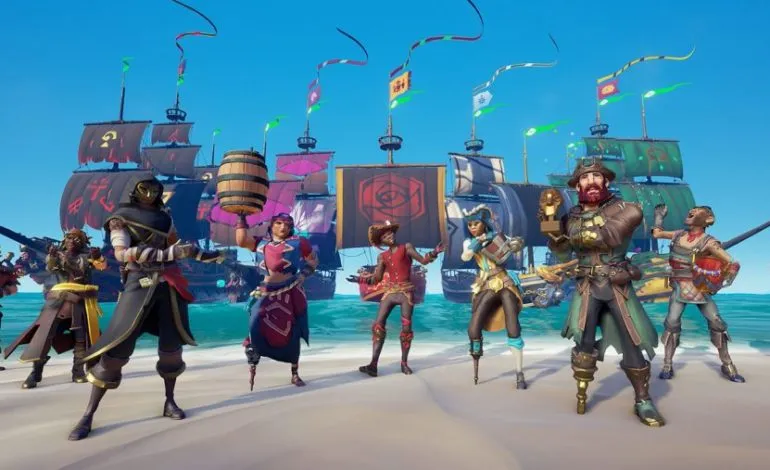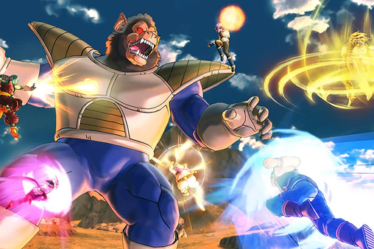
This article was originally published in Italian on GeekGamer.it in 2018.
We’ve all been more or less witnesses to Rare’s qualitative decline after its acquisition by Microsoft for years now, and denying it would simply be disrespectful to its glorious past. Its debut on Xbox 360 with the duo of Kameo and Perfect Dark Zero presented the general public with two works – historically linked to the Nintendo brand and then re-proposed exclusively for Microsoft consoles – that were met with a few too many raised eyebrows, perhaps due to the lack of mechanics that could somehow surpass those proposed in the past, or perhaps due to a technically captivating but aesthetically unalluring graphical presentation. The historic studio’s subsequent works – which began to suffer significant defections right after the acquisition – materialized in a new IP, the highly forgettable (albeit extremely relaxing) Viva Piñata!, and in the least appreciated chapter of the Banjo-Kazooie saga.
Avoiding dwelling on the enormous compilation of Rare titles published exclusively for Xbox One (one of the console’s best exclusives) and on the string of products touched by the very promising Kinect project and destined for oblivion after its failure, it appears evident that the British team’s future seems to be hanging by a thin thread. Sea of Thieves represents the company’s latest project and, probably, one of its most ambitious works. In early access for ages and the result of four years of development conducted hand-in-hand with thousands of testers, Microsoft’s new video game has finally reached the starting line, distributed in stores and on digital storefronts. The idea behind the video game, previously known as Project Athena, was to bring together a good number of players under its “roof” thanks to cooperative online gameplay based not only on teamwork but also, and above all, on the need to establish voice chat communication with both companions and opponents. As it turns out, the original theme was not linked to exploring sun-drenched bays and recovering submerged treasures; in any case, Sea of Thieves is sold today as a colorful pirate simulation enjoyable even solo, although its structure tacitly invites you to bring along – or build, by playing – a close-knit group of friends.
Fortunately, the title in question is also accessible thanks to Xbox Game Pass, the monthly subscription service that allows, for an honest sum, access to a playlist of games belonging to both the current and previous console generations without any restrictions; alternatively, purchasing a digital copy gives the possibility of sharing the gaming experience via Xbox Play Anywhere between console and PC. To best enjoy the copy that Microsoft kindly granted me for review purposes, I was able to use my Xbox One X and my gaming-dedicated personal computer, while also enlisting a friend as a member of my very own crew. Once the sail was set, pushed by the breath of my naive enthusiasm, I embarked on the world of Sea of Thieves expecting what many other multiplayer titles had failed to provide, hoping that the Microsoft brand and the project’s long gestation period would guarantee I wouldn’t stumble upon yet another “early access” sold as a retail copy. The result?
After selecting my avatar from a series of pre-made models, Sea of Thieves literally threw me onto an island inhabited by a series of NPCs ready to sell me items, as well as representatives of three guilds, all interested in having me complete a series of missions, promising lavish rewards in the form of shiny golden doubloons. Having chosen to manage a small-sized vessel (we had decided to experience the adventure only as a duo), navigation didn’t prove particularly difficult, despite the lack of any kind of dedicated tutorial.
I must admit that the Rare title certainly doesn’t lack the right pirate atmosphere, and the available “technical know-how” has allowed for the creation of a “themed” universe in the most credible way possible, even if filtered through a characteristic cartoonish vein; the aesthetic rendering of the navigation sessions is extremely fascinating and brought to life by highly impactful scenic details. Witnessing the sea waves crashing against the bow of one’s ship, as well as the erratic movement of the clouds in the sky, is extremely gratifying and plays a fundamental role in immersing oneself in the game’s universe. When the weather is mild, the waters calm down and make the progress of one’s vessel an almost relaxing activity; during storms, however, one can only pray not to crash against rocks hidden until a moment before by the high sea waves. If navigation (and the impact of weather on it) are perhaps the production’s flagship, the marine ecosystem of Sea of Thieves doesn’t prove to be as multifaceted, suffice it to say that it consists of only two creatures: the Kraken, whose random appearance ensures the destruction of the vessel, and sharks, ready to swallow in a single bite any unfortunate adventurers who cross their path while swimming. The various fish, corals, and occasional starfish one observes here and there represent only an ornamental and non-interactive element, probably put there to deceive the eye of the more demanding player, ready to go on the warpath the moment the long-awaited title proves to be poor in content.
And speaking of content, the variety of enemies in Sea of Thieves basically includes the aforementioned sharks, the kraken (which seems more like a random event), and skeletal humanoids, divided into four types. That’s it. If, instead, we consider the recoverable items during exploration, the offering proves just as desolate: bananas, for restoring health, cannonballs, and wooden planks, used to repair any damage to the ship. The impossibility of recovering special items or important treasures during free exploration thus devalues in one fell swoop the “sense of wonder” of the first moments, simultaneously extinguishing the natural thirst for adventure that arises from being faced with such an aesthetically fascinating reconstruction of eternal pirate navigation.
The items purchasable with the in-game currency that rewards those who commit to completing the (all identical and randomly generated) missions of the three guilds present in the game are purely decorative and do not modify in any way the statistics or abilities of the players – not to mention their cost, which always remains very high. These missions consist of simple triggers that initiate events, so much so that only after accepting one is it possible, upon returning to a previously explored island, to witness the sudden appearance of enemies or caches of recoverable items not present before. From such a crudely designed mechanism based on the “ad infinitum” repetition of the same actions, one could only expect a true sense of progression, just as one doesn’t expect it from the majority of online games, which justify hours and hours of unbridled “grinding” for player growth in terms of levels or statistical points.
Well, Sea of Thieves informs that it is possible to increase one’s relevance with each guild (in the form of popularity levels) simply by completing these missions, but the final gratification remains once again purely aesthetic and materializes in access to colored variants of tools and weapons already in possession from the beginning of the game. It is unclear how Rare could have thought of creating a product in which hours and hours of gameplay lead to the repetition to exhaustion of the two or three proposed activities, in a world inhabited by only three types of enemies and in which it is possible to find only the same three items even in hidden caves and on solemn altars positioned in places that would suggest the presence of something else entirely. If then completing the only three proposed actions implies entirely frivolous gratifications, it is clear that we are faced with one of those cases in which the authors would like to convince us that “the journey is worth much more than the destination.” On closer inspection, the effort required to find Sea of Thieves interesting for more than a few hours is hardly worth the candle, even after trying the “incredible” experience of communicating via voice chat with other players.
To be fair, in fact, there are additional activities related to the end game that become accessible only after reaching a high level with the aforementioned guilds (but who would make you do that?). A quicker way to access them is to plunder certain islands specifically marked by skull-shaped clouds during navigation. In these moments, entirely comparable to real “PVE Raids,” the game shows its worst side: our avatar finds itself completely powerless against an incredible number of enemies, capable, moreover, of sinking enemy ships with cannons by aiming with surgical precision.
These situations were clearly designed to place players in conditions of clear inferiority and encourage them to collaborate and interact. But if this was the authors’ expectation, one must recognize its pastoral naivety: in a world populated by anonymous users often embodying the lowest qualities of humankind, reality proves to be profoundly different from any “cooperative utopia,” and it is not so rare to witness the indiscriminate killing of enemies even in situations where this would not ensure any advantage to the perpetrator. Committing for hours to an activity that could at any moment – and without any warning – result in nothing, when that result is already worth so little, therefore remains truly unattractive. It seems, in short, that Rare tried to create a world without fixed rules, punishments of any kind, or penalties whatsoever, in the hope that a sort of ethical code could be spontaneously generated, as if in the year of our Lord 2018 there were no precedents capable of teaching something in this regard. The setting is certainly piratical, but the experience is in fact not very dissimilar to that of any VRChat (and the enthusiasm of novelty fades in the same fraction of time).
And speaking of the much-vaunted multiplayer experience, which is then the core concept of the entire project, it should be noted that at the time of writing, Sea of Thieves lacks any type of tutorial, whether written or verbal, while on-screen information is practically absent. Thus, even the management of matches and one’s own team is practically reduced to the bare minimum: if it weren’t for the possibility of consulting the list of nicknames of one’s crew members, it wouldn’t even seem like playing an online title.
At any time, a party member can disconnect without the others being aware of it, and it is not even allowed to check the health status of one’s companions or their nearby position, just for convenience. Even the importance of the ship on which one sails is completely nullified by the possibility of seeing it sink without suffering any real consequence (except for the loss of any cargo of chests and items recovered during missions), and what should be the equivalent of a “home,” unique in its kind and loved by its owners, functions as little more than a respawn point that can be moved here and there, depending on needs. Customizing the appearance of the ships is very expensive, and in any case, the two types available (a large one, suitable for a group of players, and a smaller one, for one or at most two people) are identical for all players, so much so that I often found myself confusing my vessel with that of opponents.
That said, I am happy to state that in Sea of Thieves you can still get drunk like real pirates and play a good two (2) musical instruments while waiting for your avatar – after staggering sufficiently – to vent their hangover in colorful and “hilarious” spurts of vomit. Incredible but true, the product of a few too many glasses of Grog can be collected with a standard-issue bucket to then be thrown in enemies’ faces to blind them. Talk about attention to detail and the considered priorities of a development team. And to conclude the discussion, one last clarification for lovers of graphic tidbits: the Xbox One X and PC versions are practically identical, apart from a frame-per-second lock on console inextricably linked to the figure of 30 at a native 4K resolution. The PC version is clearly superior, but apparently, Rare was not able to include a way to exit the game without resorting to the good old alt+F4. Keep it up.
This article was originally intended as a pre-review in the hope that the game would be patched and enriched with content, but ultimately Sea of Thieves is sold today as a finished and polished product, and perhaps the time has also come to say enough to paid “early access,” especially when they are not even declared. The Rare title certainly does not lack ambition, but the final execution is, to say the least, emblematic. It is not clear how the universe of Sea of Thieves will evolve in the future, beyond a first major patch planned for June, but what is certain is that today spending the price requested by Microsoft for the equivalent of a pirate-themed voice chat with themed activities – of mediocre quality – seems a tad too much to me. Second Life remains free and is probably more comparable to the concept of a “video game” than this product.
Sea of Thieves is a gorgeous shell of a game—visually stunning, atmospherically rich, but woefully shallow. Rare’s ambitious pirate sandbox offers little reward for your time, with repetitive missions, minimal content, and a multiplayer experience that leans too heavily on player goodwill. Despite a promising concept, there’s little substance beneath the waves. A missed opportunity from a once-legendary studio.


